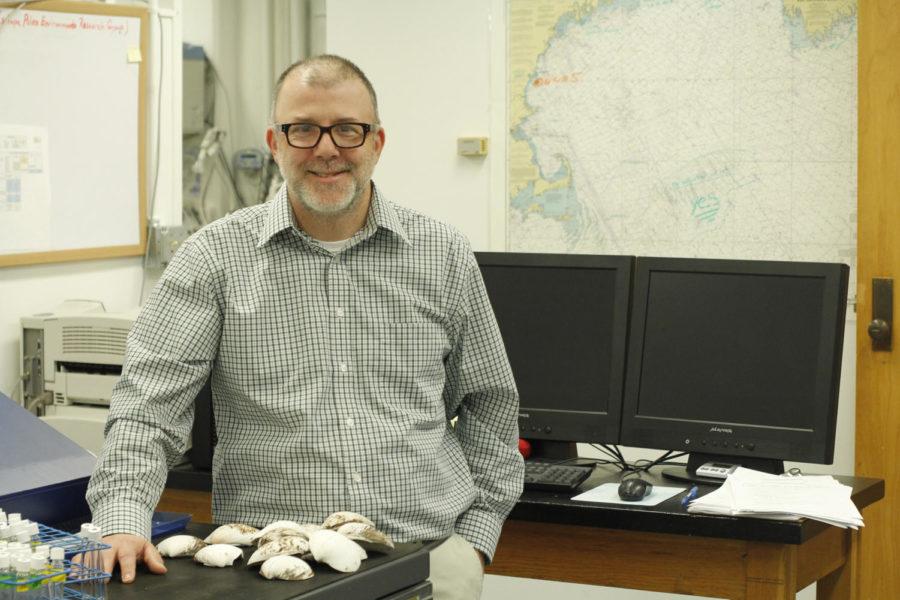Clam shell research uncovers past millennium’s history
Chris Anderson/Iowa State Daily
Alan Wanamaker poses with ocean quahogs. The quahogs were used as proxy specimens for his research on ocean climate change.
January 11, 2017
For the first time, a millennium’s worth of ocean climate variations in the North Atlantic has been revealed by a team of researchers working with clam shells.
Working with a team led by David Reynolds at Bangor University in North Wales, Alan Wanamaker, a paleoclimatologist and associate professor of geological and atmospheric sciences at Iowa State, sampled nearly 1,500 isotopes from a variety of clam shells.
The clam shells, collected in 2006 in the North Atlantic, were from a variety of different time periods, but the same water depth. Some clam shells were between 400 and 500 years old, while others were alive 200 years earlier. This time difference allowed for the growth patterns to overlap in the shells.
“You can think of these shells as mini trees where they will have a narrow ring or a big ring — a good year or a bad year,” Wanamaker said. “What we do is compare the relative growth patterns through time, and when the unique barcode matches, we can extend the chronology back in time.”
Reynolds worked on isotopes in the series and sampled each increment in the clam shell for over a thousand years. This resulted in him being able to get material from every year for over 1,000 years.
“Largely, what we have is a chemical signature that is telling us about the ocean conditions at that location at that time,” Wanamaker said. “From that, we could compare it to other records on land or in the ocean and look at relative timings of these climatic events.”
One of the unique aspects of this work is that it’s the first time an annual record from the oceans has been produced without dating errors. In the past, radiocarbon dating on coral or sediment cores was used and there could be 50-year discrepancies, which made it harder to draw conclusions.
The team was able to compare the data with land-based records. One of its findings was that, for the first 800 years of the record, the ocean was leading the atmosphere in terms of warming or cooling. But after the industrial revolution around 1800, it seems that the ocean is now following what the atmosphere is doing.
“There was fundamentally a major shift in the climate system and that is very likely related to greenhouse gases,” Wanamaker said. “What the record does is it shows us the natural variability of the systems through time, but as we start to introduce greenhouse gases into the atmosphere, we see that shift is coincident.”
Wanamaker is certain the research he was a part of will be used by the community.
“Perhaps it will be used for the Intergovernmental Panel on Climate Change,” he said. “That is the frontier on climate change, and if we could contribute to that document, then that would be something to be really excited about.”
The data sets are currently on the NOAA Paleoclimatology site, and Wanamaker’s hope is that other people get the records to do their own analysis and comparison or even be used by policy makers.
Wanamaker explained the importance of research at any level, saying, “In the simplest sense, on any given project, we might be hyperfocused on the science or our questions, but most of the time, these techniques that we use to try to figure out the work are applicable to other problems.”
He believes training students to be critical problem solvers and being open-minded on big problems is to everyone’s advantage.
His advice to Iowa State students interested in doing research is to find what makes them excited.
“There’s all sorts of opportunities out there,” Wanamaker said. “We need problem solvers in science, in social issues, in policy issues, but critical thinking, understanding the problems and how we try to work on them is really important.”
Looking forward, Wanamaker hopes to expand the research to other areas along the Atlantic and to go further back in the timeline.
“Despite this being a 10-year project, it was just one location in the oceans,” Wanamaker said. “Iceland is a strategic location, but we need to understand the spatial variability of climate through times, not just what was happening north of Iceland, but other locations.”
A group at Iowa State is currently working in the Gulf of Maine and northern Norway, and other colleagues are working in other key locations along the path of the gulf stream to collect similar data.
















